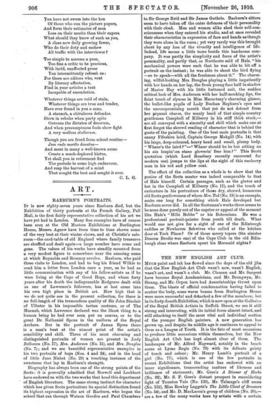ART.
RA_EB1T1tN'S PORTRAITS.
IT is now eighty-seven years since Raeburn died, but the Exhibition of thirty portraits at the French Gallery, Pall Mall, is the first fairly representative collection of his art we have yet had in London. Many fine examples have of course been seen at the Old Masters Exhibitions at Burlington House, Messrs. Agnew have from time to time shown some of the very beat at their winter shows, and at Christie's sale- room—the card-table of old England where family treasures are shuffled and dealt again—a large number have come and gone. The values of his works have steadily mounted from a very modest figure to somewhere near the amazing sums at which Reynolds and Romney revolve. Raeburn, who paid three visits to London, and had to beg his friend Wilkie to send him a letter from London once a year, as he had as little communication with any of his fellow-artists as if he were living at the Cape of Good Hope, and whom forty years after his death the indispensable Redgrave dealt with as one of Lawrence's followers, has at last come into his own high place in British art. How high that is we do not quite see in the present collection, for there is no full-length of the tremendous quality of Sir John Sinclair of Ulbster in his impossible tartan costume, or of The Macnab, which Lawrence declared was the likest thing to a human being he had ever seen put on canvas, or to the great Dr. Nathaniel Spens in the uniform of the Royal Archers. But in the portrait of James Byres there is a man's bust at the utmost point of the artist's sensibility and skill. Three of his most charming and distinguished portraits of women are present in Lady Belhaven (No. 17), Mrs. Anderson (No. 15), and Mrs. Douglas (No. 7) ; and we see beautiful representative examples in his two portraits of boys (Nos. 4 and 24), and in the head of little Jane Nisbet (No. 29) a touching instance of the sweetness that lay in Raeburn's strength.
Biography has always been one of the strong points of the Scots: it is generally admitted that Boswell and Lockhart have endowed us with the two works that head this department of English literature. The same strong instinct for character which has given Scots portraiture its special distinction found its highest expression in the art of Raeburn, who began the school that ran through Watson Gordon and Paul Chambers to Sir George Reid and Sir James Guthrie. Raeburn's sitters seem to have taken off the outer defences of their personality with their cloak. Alen and women alike shed their self-con- sciousness when they entered his studio, and at once revealed their characteristics in expression of face and hands as though they were alone in the room; yet very rarely was this brought about by any loss of the vivacity and intelligence of lire. Indeed, life seems a little tame beside this handsome com- pany. It was partly the simplicity and force of the artist's personality, and partly that, as Northoote said of Hats, "his mechanical powers were such that he was able to hit off a portrait on the instant ; he was able to shoot the bird flying —so to speak—with all the freshness about it." The charm- ing, wilful-looking Mrs. Douglas playing a little impatiently with her hands on her lap, the fresh young face half in shadow of Master Hay with his little buttoned suit, the sudden critical look of Mrs. Anderson with her half-mocking lips, the faint touch of slyness in Miss Macartney's charming glance, the bullet-like pupils of Lady Buchan Hepburn's eyes and the uncompromising mouth that yet do not detract from her piquant charm, the manly head of that simple country gentleman Campbell of Kilberry in his stiff thick stock,— are all conveyed with a sincerity and skill which make one at first forget the shrewd reading of character that is behind the gusto of the painting. One of the best male portraits is that canny Fifeshire laird, Captain George Makgill (No. 14), with his large, deep-coloured, heavy head and small, plump body. " Whaur's the laird P "—" Whaur should he be but sitting on his am n loupin'-on stane glowerin' frae him P " This Scott quotation (which Lord Rosebery recently recovered for modern use) jumps to the lips at the sight of this uncheery man in his red and yellow coat.
The effect of the collection as a whole is to show that the genius of the Scots master was indeed comparable to that of Hals himself. Certain passages, such as the gloves and hat in the Campbell of Kilberry (No. 11), and the touch of caricature in his portraiture of those dry, shrewd, humorous old Scots gentlewomen of whom Mrs. Tod (No. 19) is an example, make one long for something which Hals developed but Raeburn never did. In all the Scotsman's works there seems to be none done purely out of the caprice or appeal of the moment like Hale's " Hille Bobbe " or his Bohemians. He was a professional portrait-painter from youth till death. What would one not give for a sight of one of the Edinburgh caddies or Newhaven fishwives who called at the kitchen door at York Place ? Or of those merry topers (the sinister Deacon Brodie was one) of the Cape Club in the old Edin- burgh close where Raeburn spent his Mermaid nights P


















































 Previous page
Previous page